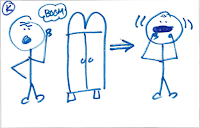It is a twist on the traditional running dictation. A running dictation is very much like a regular dictation, except there is a running aspect, and it is like the game Telephone. Outside of the classroom or on the opposite wall (depending on the size of the room), there is paper which has the dictation sentences in the target language. Students are teamed up usually in pairs, where one student is a runner, and the other is a writer. The runner runs to the paper, tries to remember as much as possible, runs back to the writer, and dictates the sentence or as much as possible. The writer writes it down, the writer and runner then switch roles, with the writer now running and the runner now writing.
I am not a big fan of running dictations, because not every student enjoys it or sees the purpose in it. Because the sentences may not be completely comprehensible to the students, the runner does not always understand what he/she is dictating to the writer. Plus, a lot of times, it becomes a spelling activity for the writer. In addition, when I look over the dictations, many times I do not understand what was written due to spelling errors and the "telephone" effect of the sentence changing. Annabelle's idea changes it into a comprehension activity but still preserves the running aspect.
Pre-Class Directions
- Create sentences in the target language from a known story, and create a document of those sentences. I used 12 sentences and found that it was a good number.
- Illustrate (or use screenshots) for those sentences. You will also need to label the picture as "A," "B," "C", etc.
- Print up the Running Dictation pictures.
- Print up Running Dictation sentences - usually ½ of total number of students which you have.
Classtime
- Put up the pictures along a wall in a random order either in the room or outside of the classroom.
- Divide up class into teams of 2 or 3.
- Each team will need a writing surface and a writing utensil.
- Give the list of running dictation sentences to each team.
- Explain that one person will sit with sentences and the other person will run to ONE of the pictures. It is not necessary for them to run to the pictures in order but rather to run to just one of the pictures.
- The person who runs will look at the picture, memorize which letter that picture is, run back to the partner, and describe the picture in English.
- The person with the sentences will then determine what sentence that picture is and write down the letter.
- Then, the two will switch roles - the writer will now become the runner, and the runner will then become the writer.
- Explain that they may NOT use their phones to take a picture! They again can only look at one picture at a time.
- When they have gotten all of the sentences, they are then to put the story in order based on the letters.
Examples from Monster in the Closet



___________. Senex in lecto dormiebat.
___________. Puer non erat in lecto, sed monstrum erat in lecto!
___________. Quamquam senex erat iratus, in lecto ascendit.
___________. Puer non dormiebat, et timebat.
___________. Sed subito aliquid magnos sonos facit.
___________. Senex vidit puerum in armario.
___________. Puer in armario magnos sonos faciebat.
___________. Aliquid magnos sonos faciebat in armario!
___________. Cum senex magnos sonos in armario audivit, timebat.
___________. Puer respondit, “Monstrum est in armario!”
___________. Senex vidit puerum in lecto.
___________. Senex respondit, “Tempus est obdormire!”
Once you are done, put the story back in order by the above letters
______ 1. ________ 5. _________ 9.
______ 2. ________ 6. _________ 10.
______ 3. ________ 7. _________ 11.
______ 4. ________ 8. _________ 12.
______ 1. ________ 5. _________ 9.
______ 2. ________ 6. _________ 10.
______ 3. ________ 7. _________ 11.
______ 4. ________ 8. _________ 12.
Observations
- Wow, I liked this version of a running dictation SO much better than the traditional one.
- Turning the running dictation into a comprehension activity made it a higher-level thinking activity, since in a regular running dictation, if the runners did not understand what they were saying, then they were just parroting unknown words.
- Even though runners are reporting back to the writers in English (I suppose they could do it in L2), there is a purpose for it, since the writer needs that information to determine which sentence it is in L2.
- Annabelle recommends that you as the teacher be near the pictures to clarify them for students if needed. I found this to be helpful for students, because sometimes they could not interpret my pictures.
- I liked that lots of higher-level collaboration happened when students were putting the story back in order according to letter. Yes, it was happening in English, but students were solely using the sentences in the target language.









No comments:
Post a Comment